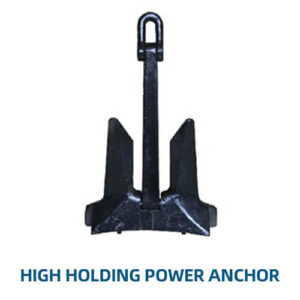Key Features of an Anchor Chain:
- Design and Construction:
- Material: Anchor chains are typically made from high-tensile steel, which offers excellent strength, durability, and resistance to corrosion, especially in the harsh marine environment. The steel is often galvanized or coated with other protective materials to enhance its resistance to rust and wear.
- Chain Links: The chain is composed of individual links that are oval or stud-linked. Stud-linked chains are preferred in marine applications because the stud (a bar across the center of each link) prevents the chain from kinking and adds strength.
- Chain Diameter: The diameter of the chain links varies depending on the size of the vessel and the required holding capacity. Larger ships require thicker, more robust chains to handle the greater forces involved.
- Proof Testing: Anchor chains undergo proof testing to ensure they meet specific strength and durability standards. This involves applying a load to the chain to verify it can withstand the forces it will encounter during use.
- Functionality:
- Weight Distribution: The anchor chain’s weight plays a critical role in the anchoring system by helping to keep the anchor at the correct angle for maximum holding power. The chain’s weight ensures that the anchor lies flat on the seabed and digs in properly.
- Shock Absorption: The anchor chain acts as a shock absorber, dampening the forces exerted by waves, currents, and wind. This reduces the strain on the anchor, the vessel, and the anchoring system as a whole.
- Holding Power: The chain’s length and weight contribute significantly to the holding power of the anchor. A longer chain allows the anchor to maintain a more horizontal pull, which increases its ability to stay embedded in the seabed.
- Types of Anchor Chains:
- Stud-Link Chain: The most common type of anchor chain, designed with a central stud to prevent kinking and add strength. These chains are used on commercial ships, large yachts, and naval vessels.
- Studless Chain: Lacks the central stud and is more flexible and lightweight, often used on smaller boats where weight savings are important.
- High-Test Chain: Made from high-strength steel, these chains are lighter yet stronger than standard chains, allowing for reduced weight without compromising strength. They are typically used on vessels where space and weight are at a premium.
- Applications:
- Commercial Shipping: In large commercial vessels, such as cargo ships and tankers, anchor chains must be extremely robust to handle the massive forces involved when anchoring such large vessels.
- Naval and Military Vessels: Military ships use anchor chains that meet stringent standards for strength, durability, and corrosion resistance, ensuring reliability in all conditions.
- Recreational Boats and Yachts: Smaller, lighter chains are used in recreational boating, but they must still be sufficiently strong to secure the vessel in varying conditions.
- Offshore Platforms: Anchor chains are also used to secure offshore platforms and structures, providing stability in the open sea.
- Performance and Benefits:
- Durability: Built to withstand harsh marine environments, anchor chains are highly resistant to corrosion and wear, ensuring long-term reliability.
- Strength: The high tensile strength of the steel used in anchor chains provides the necessary load-bearing capacity to secure vessels of all sizes.
- Ease of Use: Anchor chains are designed for smooth operation, whether being deployed or retrieved, and they work seamlessly with windlasses and capstans.
- Maintenance and Care:
- Regular Inspection: Regularly inspect the anchor chain for signs of wear, corrosion, or damage. Links that are worn, elongated, or cracked should be replaced immediately to avoid failure during anchoring.
- Lubrication and Coating: Some chains may require periodic lubrication or re-coating with protective materials to prevent rust and corrosion, particularly in harsh environments.
- Storage: When not in use, the anchor chain should be stored properly to prevent tangling, kinking, and exposure to moisture that could lead to corrosion.
- Safety Considerations:
- Proper Sizing: It’s crucial to select an anchor chain that is appropriately sized for the vessel and its intended anchoring conditions. A chain that is too light or weak may fail under load, putting the vessel at risk.
- Correct Deployment: Ensure that the chain is deployed at the correct length (scope) relative to the water depth and conditions. A scope of 5:1 to 7:1 (length of chain to water depth) is generally recommended for safe anchoring.
- Emergency Preparedness: Be prepared for emergency situations by knowing how to quickly deploy or retrieve the anchor chain, and ensure that the chain locker is clear and well-maintained for rapid access.
Advantages of an Anchor Chain:
- Increased Holding Power: The weight and length of the anchor chain significantly enhance the holding power of the anchor, providing better security in various seabed conditions.
- Durable and Long-Lasting: Anchor chains are designed to last, withstanding the stresses of the marine environment for many years with proper maintenance.
- Flexibility: The use of chain allows for greater flexibility in anchoring, accommodating different seabed types, water depths, and weather conditions.
Considerations for Anchor Chains:
- Weight: The weight of the anchor chain adds to the vessel’s overall displacement, which can affect fuel efficiency and handling. This is a particularly important consideration for smaller vessels.
- Cost: High-quality anchor chains, particularly those made from specialty materials or with additional coatings, can be costly. However, the investment is justified by the increased safety and longevity.
- Compatibility: Ensure that the anchor chain is compatible with the vessel’s windlass, capstan, and anchor. The chain’s size, link shape, and length must match the equipment specifications.
Anchor chains are vital components of the anchoring system, providing the strength, weight, and flexibility needed to secure vessels in a wide range of conditions. Their durability and reliability make them indispensable for maritime safety, ensuring that vessels remain securely anchored regardless of the environmental challenges they may face.






